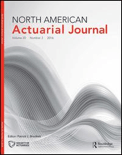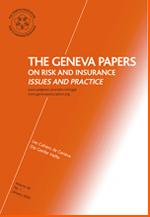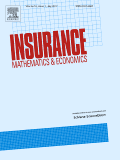
North American Actuarial Journal
Scope & Guideline
Advancing Actuarial Insights for Tomorrow's Challenges
Introduction
Aims and Scopes
- Quantitative Risk Assessment:
The journal emphasizes the development and application of quantitative models to assess and manage risk across various domains, including life, health, and property insurance. - Innovative Insurance Solutions:
Research often explores innovative insurance products and strategies, including health insurance models, catastrophe bonds, and telematics-based pricing, aiming to enhance the effectiveness and inclusivity of insurance. - Mortality and Longevity Studies:
A significant focus is placed on mortality modeling and longevity risk, including the analysis of demographic trends and their implications for actuarial practice and financial planning. - Data-Driven Decision Making:
The journal promotes the use of advanced data analytics and machine learning techniques in actuarial science, facilitating better decision-making and predictive modeling in insurance. - Health Economics and Actuarial Science:
Research on health economics intersects with actuarial science, addressing issues like healthcare costs, insurance affordability, and the impact of public policies on insurance markets.
Trending and Emerging
- Telematics and Usage-Based Insurance:
Recent publications have increasingly focused on telematics data and its applications in insurance pricing and risk assessment, highlighting a trend towards more personalized and usage-based insurance models. - Health Insurance Innovations:
Research on innovative health insurance models, particularly in response to the COVID-19 pandemic, is gaining traction, emphasizing the need for adaptive strategies in health insurance provision. - Climate Risk and Sustainability:
There is a growing emphasis on modeling climate-related risks and developing sustainable insurance products, reflecting broader concerns about environmental impacts and the future of insurance in a changing climate. - Machine Learning and Advanced Analytics:
The integration of machine learning and advanced analytics into actuarial practices is becoming increasingly prominent, with studies exploring their applications in risk assessment, underwriting, and claims management. - Social Determinants of Health and Insurance:
An emerging focus on the impact of social determinants on health outcomes and insurance costs is being observed, indicating a trend towards more holistic approaches in health actuarial science.
Declining or Waning
- Traditional Risk Models:
There has been a noticeable decrease in publications centered on traditional risk models, possibly indicating a shift towards more complex and data-driven methodologies that account for nonlinearities and dependencies. - Static Insurance Pricing Models:
Research focusing on static pricing models is waning, as the industry increasingly adopts dynamic pricing strategies informed by real-time data and machine learning algorithms. - Basic Mortality Tables:
The use of basic mortality tables for actuarial calculations appears to be decreasing, with more sophisticated models being favored that incorporate a wider range of demographic factors and trends. - Single-Dimensional Risk Assessments:
There is a decline in studies that focus solely on single-dimensional risk assessments, as multidimensional approaches that consider various interrelated risks gain prominence.
Similar Journals

JP Journal of Biostatistics
Transforming Healthcare Outcomes with Biostatistical ExcellenceJP Journal of Biostatistics is a reputable academic journal published by PUSHPA PUBLISHING HOUSE, focusing on the dynamic field of biostatistics. With an ISSN of 0973-5143, it aims to publish high-quality research articles, reviews, and case studies that contribute significantly to biostatistical methodologies and their applications in various disciplines, including public health, clinical trials, and biosciences. Though the journal is behind a subscription model, it is dedicated to advancing the field by providing valuable insights and innovative approaches that are essential for researchers, professionals, and students alike. By fostering a collaborative academic environment, the JP Journal of Biostatistics emphasizes the importance of rigorous statistical analysis in improving healthcare outcomes and shaping evidence-based policies. Positioned in the vibrant research landscape of India, the journal plays a crucial role in disseminating knowledge and supporting the global biostatistics community.

Mathematics and Financial Economics
Advancing Insights at the Intersection of Math and FinanceMathematics and Financial Economics, published by Springer Heidelberg, is a leading peer-reviewed journal that explores the intersections of mathematical theories and financial practices. With an ISSN of 1862-9679 and an E-ISSN of 1862-9660, the journal has made notable contributions to its field since its inception in 2007, with a convergence period extending until 2024. Positioned in the prestigious Q2 category for both Finance and Statistics and Probability, the journal is ranked within the top 66th percentile in Mathematics and Statistics and the 62nd percentile in Decision Sciences according to Scopus metrics. Researchers and professionals looking for high-quality, innovative research in mathematical finance will find valuable insights within its pages. Although primarily a subscription-based journal, it aims to foster knowledge sharing among academia and industry experts. Its commitment to advancing quantitative methods and financial applications solidifies its importance as a resource for students, researchers, and practitioners dedicated to understanding and navigating the complex dynamics of financial markets.

Probability Uncertainty and Quantitative Risk
Transforming Uncertainty into Knowledge and SolutionsProbability Uncertainty and Quantitative Risk, published by the American Institute of Mathematical Sciences (AIMS), is a distinguished open-access journal that has been contributing to the academic community since its inception in 2016. With a focus on the crucial interplay between probability, uncertainty, and quantitative risk assessment, this journal serves as a vital platform for researchers, practitioners, and students engaged in the fields of Applied Mathematics and Statistics. The journal's ranking in the Q2 category for both Applied Mathematics and Statistics and Probability reflects its growing influence and relevance, while its diverse scope encourages interdisciplinary studies. As a part of the Scopus database and maintaining a consistent publication pace through 2024, Probability Uncertainty and Quantitative Risk is essential for anyone looking to remain at the forefront of research in risk analysis and uncertainty modeling. Its commitment to open access since 2016 further enhances accessibility to cutting-edge findings, making it an indispensable resource for academics and industry professionals alike.

GENEVA PAPERS ON RISK AND INSURANCE-ISSUES AND PRACTICE
Elevating Standards in Risk Assessment and Policy DevelopmentGENEVA PAPERS ON RISK AND INSURANCE-ISSUES AND PRACTICE is a leading academic journal dedicated to advancing the fields of risk management and insurance, published by the esteemed Palgrave Macmillan Ltd. With an ISSN of 1018-5895 and an E-ISSN of 1468-0440, this journal serves as a pivotal platform for sharing cutting-edge research and practical insights addressing a diverse range of issues within the insurance sector. Established in 1999, it spans a wide array of topics, including risk assessment, financial implications, and policy development, contributing to its recognition in the Q2 quartile across multiple categories such as Accounting and Economics. With a notable Scopus ranking reflecting its relevance—ranked #229/716 in Economics and Econometrics, and #106/317 in Finance—it provides invaluable resources for scholars, professionals, and policymakers alike. Despite being a non-open-access journal, the GENEVA PAPERS ensures a rigorous peer-review process, aiming to uphold the highest standards of scholarly publication. Whether you are a researcher looking to publish groundbreaking studies or a practitioner seeking the latest trends and analyses in the insurance landscape, this journal stands out as an essential resource in the domain.

Decisions in Economics and Finance
Fostering Excellence in Economic Decision-MakingDecisions in Economics and Finance, published by SPRINGER INT PUBL AG, is a leading journal in the fields of economics, econometrics, and finance, providing a critical platform for researchers, professionals, and students to disseminate their findings and insights. With an impressive impact factor positioned in the Q2 category for both Economics and Finance in 2023, this journal is recognized for its rigorous peer-reviewed process and impactful research contributions. The journal spans over areas of general economics and finance, emphasized by its Scopus rankings, which place it in the 68th and 50th percentiles respectively. Since its inception in 1997 and continuing through its conferred years, Decisions in Economics and Finance continues to foster innovative approaches to economic and financial decision-making while bridging theoretical and practical applications. While it currently does not offer Open Access options, its commitment to quality research and interdisciplinary collaboration makes it a vital resource for anyone engaged in these dynamic fields.

INSURANCE MATHEMATICS & ECONOMICS
Transforming theoretical frameworks into practical applications.Insurance Mathematics & Economics, published by Elsevier, stands as a pivotal journal in the fields of economics and statistics, carrying the ISSN 0167-6687 and E-ISSN 1873-5959. Established in 1982, this journal aims to disseminate high-quality research that integrates insurance theory with economic principles, making significant contributions to both academic and practical spheres. With a notable Q1 ranking in the 2023 category quartiles for Economics, Econometrics, Statistics, and Probability, and a solid standing in Scopus ranks, it ranks #64 out of 278 in Mathematics and #45 out of 168 in Decision Sciences, showcasing its relevance and prestige in the research landscape. The journal not only facilitates a deeper understanding of insurance-related mathematical methodologies but also emphasizes the application of these techniques in real-world economic contexts. Researchers, professionals, and students alike can benefit from its rigorous approach to the challenges faced in insurance and economics, making it an essential resource for anyone involved in these dynamic fields.

Anales del Instituto de Actuarios Espanoles
Advancing Actuarial Knowledge, Shaping Tomorrow's PracticesAnales del Instituto de Actuarios Españoles is a prestigious journal dedicated to advancing the field of actuarial science and related disciplines. Published by the Instituto de Actuarios Españoles, this journal serves as a vital platform for researchers, practitioners, and students aiming to share innovative methodologies, comprehensive analyses, and groundbreaking research that contribute to the actuarial profession. Although not an open-access journal, its rigorous peer-review process ensures high-quality publications that have garnered respect within the academic community. With an ISSN number of 0534-3232 and an E-ISSN of 2531-2308, Anales del Instituto de Actuarios Españoles plays a crucial role in disseminating knowledge that shapes actuarial practices and policies, thereby enhancing the effectiveness of the profession in addressing contemporary challenges.

ADVANCES IN APPLIED PROBABILITY
Advancing Knowledge through Probabilistic InsightsADVANCES IN APPLIED PROBABILITY is a prestigious academic journal published by Cambridge University Press, focusing on the critical intersection of applied mathematics and probability theory. With an ISSN of 0001-8678 and an E-ISSN of 1475-6064, this journal emphasizes the development and application of probabilistic models in various sectors, enhancing the rigor and reliability of statistical methodologies. Established in 1969, the journal has evolved with converged years designated up to 2024, maintaining a steady release of cutting-edge research. As a Q2-ranked journal in both Applied Mathematics and Statistics and Probability categories as of 2023, it ranks favorably within the Scopus database, demonstrating its growth in influence and relevance within the academic community, with ranks of 141/278 and 353/635 in its respective fields. Although it does not offer open access, the journal remains a vital resource for researchers, professionals, and students seeking to advance their knowledge and understanding of probability applications across diverse disciplines.

Japanese Journal of Statistics and Data Science
Cultivating Knowledge at the Intersection of Data and TheoryJapanese Journal of Statistics and Data Science, published by SPRINGERNATURE, is a leading academic journal dedicated to the advancement of statistical methodologies and data science applications, with a focus on fostering innovative research and discourse within the field. Since its inception in 2018, the journal has sought to bridge theory and practice, embracing emerging trends and interdisciplinary approaches that contribute to the ever-evolving landscape of statistics, probability, and computational theory. Hailing from Germany, the journal holds an impressive Q3 ranking in both Computational Theory and Mathematics and Statistics and Probability, reflecting its commitment to high-quality, impactful research. With an accessible ISSN of 2520-8756 and E-ISSN 2520-8764, the journal invites a global audience of researchers, professionals, and students to explore its rich array of articles and findings, all aimed at furthering knowledge and application in the realm of data science.

Journal of Risk Model Validation
Elevating Standards in Risk Assessment MethodologiesJournal of Risk Model Validation, published by INCISIVE MEDIA, is a pivotal scholarly platform dedicated to the fields of Applied Mathematics, Economics, Econometrics, and Finance. With an ISSN of 1753-9579 and an E-ISSN of 1753-9587, this journal actively contributes to the advancement of knowledge through the rigorous validation of risk models, which is essential for informed decision-making in business and economic contexts. Although currently not an Open Access journal, it serves a vital role in the academic community, evidenced by its categorization in the Q4 and Q3 quartiles across various relevant fields. As of 2023, it holds commendable Scopus rankings, reflecting its relevance and engagement within the global academic discourse. The journal encourages submissions from a wide array of researchers, professionals, and students until 2024, fostering a comprehensive exploration of risk model methodologies and their practical applications. Emphasizing both theoretical frameworks and empirical studies, the Journal of Risk Model Validation is an essential resource for those dedicated to enhancing the reliability and effectiveness of risk assessment in contemporary finance and economics.